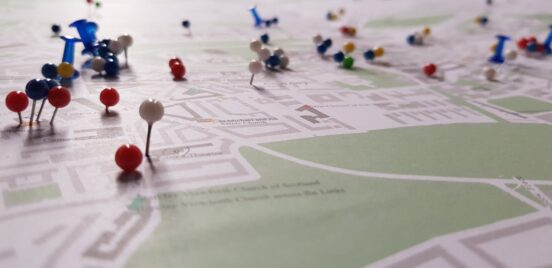I gather that your report entitled ‘Art In and Out of Lockdown’ is part of a larger project which was started before the pandemic. Would you please tell us about that project?
Yes. This report is part of the Culture and Communities Mapping Project – we put on cultural mapping events and design digital maps to look at how cultural spaces and events relate to local communities. We’ve created a cultural map of Edinburgh that came together through participatory workshops we hosted in 2019 (www.edinburghculturalmap.org). We’ve also worked with the local arts organisation LeithLate to design a digital walking tour of murals and art studios in the Leith neighbourhood. And right now, we’re working with Festivals Edinburgh and the Fringe Festival on a digital map that puts Festival activity in relation to different neighbourhoods in Edinburgh. For us as researchers, the project generally explores how community mapping, data and online tools can help us reflect on Edinburgh’s cultural geography and steer the city in a more inclusive manner.
In this report you ask how Edinburgh’s cultural institutions are supporting local communities. First, what was your methodology for gathering data during the lockdown. Secondly, what were your main findings?
For this report we approached local arts institutions, plus a few festivals and the Council’s culture department, to talk about how they are adapting during the lockdown and with Covid restrictions. We conducted interviews with eight organisations in total – the decision over which ones to approach came out of our 2019 mapping workshops, which identified a handful of organisations that participants felt were key cultural hubs for local communities.
Our main findings are dealt with in six sections in the report: first, the creative ways these institutions pivoted, quickly, to support local communities during the lockdown – in some cases, offering vital resources, such as food and ipads for online learning and communication. Second, the sudden need to rethink buildings and live events in terms of safety restrictions, and the loss of spontaneous physical interactions. Third, the abrupt funding and staffing challenges that arose, including the emotional toll of fiscal uncertainty; some interviewed pointed out how the pandemic has exposed the more fundamental lack of investment in arts and culture in the UK. Fourth, the renewed concerns for diversity, equity and inclusion that came out in 2020, both because of what the Black Lives Matters movement has shown about the colonial legacy of many cultural institutions and public statues, but also because of the local disparities that the pandemic exposed. Fifth, people we spoke to talked about all the work they did to switch to digital programming and outreach, such as online workshops and online funding campaigns; a few pointed out that switching online has the potential to build audiences outside the city, but also creates new divides for those lacking connectivity. Finally, people talked about how this time period has created opportunities to make programs more sustainable and to rethink the tourist-centric strategies of festivals and culture in Edinburgh, to focus more on local communities.
‘Equity, diversity and inclusion’ was an interesting theme of the report. The recent discussion about the Black Lives Matter movement in Edinburgh makes this particularly relevant. Could you set out the results of your research in the field of empowering Edinburgh’s ethnic communities during the pandemic?
This research project itself did not do anything to empower Edinburgh’s ethnic communities. We did talk to people about efforts in this regard:
The Council, for instance, announced a Diversity and Inclusion fund in February of 2020 of £100,000 to be dispersed to Black, Asian and minority ethnic artists and Edinburgh-based organisations. The grants range from £5000-20,0001.
Museums & Galleries Edinburgh (the department of City of Edinburgh Council which operates its cultural venues) has committed to eight priority actions in its developing anti-racism pledge, including comprehensive anti-racist training and ensuring Black and minority ethnic people are involved in their programming and exhibition designs (accessible here: https://www.edinburghmuseums.org.uk/about/anti-racism-pledge)
The National Trust is foregrounding the role that slavery and imperialism played in the history of its regal homes, in the project Colonial Countryside, which consults young black and minority ethnic children to understand the best way to communicate the past to touring audiences – including stories of slave-owners’ illegitimate children who lived on the grounds, goods looted from the Empire, and furniture made with slave-labour.
We also did respond by creating a dataset for our cultural mapping marking the legacy of slavery and colonialism in the city – this is found in the data layer on our map called ‘Edinburgh Slavery’ and is based off of local research by Lisa Williams and Uncover.Ed, among others. We also added a category to our cultural dataset that shows organisations run by or for BAME communities. The data in this category are based off of research from our cultural mapping events combined with data we received from the Council.
Morgan Currie is Lecturer in data and society in Science, Technology and Innovation Studies at the University of Edinburgh. Her research and teaching interests focus on open and administrative data, algorithms in the welfare state, activists’ data practices, civil society and democracy, social justice and the city, cultural mapping, and libraries of things. She is principal investigator of The Culture & Communities Mapping Project and co-lead the Digital Social Science Research Cluster at Centre for Data, Culture & Society.
- Photo credit: Morgan Currie





Comments by Hashemi